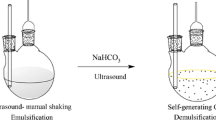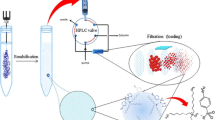Abstract
A hydrophobic ionic liquid was finely dispersed in aqueous solution along with a hydrophilic ionic liquid. Following centrifugation, the two phases aggregate to form relatively large droplets. Based on this phenomenon, a method termed ionic liquid/ionic liquid dispersive liquid-liquid microextraction was developed. It was applied to the enrichment of triclosan (TCS) and triclocarban (TCC) from water samples prior to HPLC with electrospray tandem MS detection. The type and volume of the hydrophobic ionic liquid (the extraction solvent) and the hydrophilic ionic liquid (the disperser solvent), salt content, and extraction time were optimized. Under optimum conditions, the method gives a linear response in the concentration ranges from 0.5 to 100 μg L−1 for TCC and from 2.5 to 500 μg L−1 for TCS, respectively. The limits of detection are 0.23 and 0.35 μg L−1, and the repeatability is 5.4 and 6.4% for TCC and TCS, respectively. The method was validated with four environmental water samples, and average recoveries of spiked samples were in the range from 88% to 111%. The results indicate that the method is a promising new approach for the rapid enrichment and determination of organic pollutants.

Ionic liquids [C8MIM][PF6] and [C4MIM][BF4] were used as extractant and disperser in dispersive liquid-liquid microextraction for the enrichment and determination of triclosan and triclocarban in environmental water samples prior to HPLC-ESI-MS/MS. Experimental results indicated that it was a feasible alternative to existing methods.





Similar content being viewed by others
References
Daughton CG, Ternes TA (1999) Pharmaceuticals and personal care products in the environment: agents of subtle change? Environ Health Perspect 107:907
Chu SG, Metcalfe CD (2007) Simultaneous determination of triclocarban and triclosan in municipal biosolids by liquid chromatography tandem mass spectrometry. J Chromatogr A 1164:212
Mezcua M, Gomez MJ, Ferrer I, Aguera A, Hernando MD, Fernandez-Alba AR (2004) Evidence of 2,7/2,8-dibenzodichloro-p-dioxin as a photodegradation product of triclosan in water and wastewater samples. Anal Chim Acta 524:241
Zhao R-S, Wang X, Sun J, Wang S-S, Yuan J-P, Wang X-K (2010) Trace determination of triclosan and triclocarban in environmental water samples with ionic liquid dispersive liquid-phase microextraction prior to HPLC–ESI-MS–MS. Anal Bioanal Chem 397:1627
Montes R, Rodríguez I, RubíE CR (2009) Dispersive liquid–liquid microextraction applied to the simultaneous derivatization and concentration of triclosan and methyltriclosan in water samples. J Chromatogr A 1216:205
Zhao R-S, Yuan J-P, Li H-F, Wang X, Jiang T, Lin J-M (2007) Nonequilibrium hollow-fiber liquid-phase microextraction with in situ derivatization for the measurement of triclosan in aqueous samples by Gas Chromatography-Mass spectrometry. Anal Bioanal Chem 387:2911
Zhao R-S, Wang X, Sun J, Yuan J-P, Wang S-S, Wang X-K (2010) Temperature controlled ionic liquid dispersive liquid phase microextraction for the sensitive determination of triclosan and triclocarbon in environmental water samples prior to HPLC-ESI-MS/MS. J Sep Sci 33:1842
Guo J-H, Li X-H, Cao X-L, Li Y, Wang X-Z, Xu X-B (2009) Determination of triclosan, triclocarban and methyl-triclosan in aqueous samples by dispersive liquid–liquid microextraction combined with rapid liquid chromatography. J Chromatogr A 1216:3038
Canosa P, Rodriguez I, Rubı´ E, Cela R (2005) Optimization of solid-phase microextraction conditions for the determination of triclosan and possible related compounds in water samples. J Chromatogr A 1072:107
Canosa P, Pe´rez-Palacios D, Garrido-Lo´pez A, Tena TM, Rodrı´guez I, Rubi E, Cela R (2007) Pressurized liquid extraction with in-cell clean-up followed by gas chromatography–tandem mass spectrometry for the selective determination of parabens and triclosan in indoor dust. J Chromatogr A 1161:105
Allmyr M, McLachlan MS, Sandborgh-Englund G, Adolfsson-Erici M (2006) Determination of Triclosan as its Pentafluorobenzoyl Ester in human plasma and milk using electron capture negative ionization mass spectrometry. Anal Chem 78:6542
Quintana JB, Reemtsma T (2004) Sensitive determination of acidic drugs and triclosan in surface and wastewater by ion-pair reverse-phase liquid chromatography/tandem mass spectrometry. Rapid Commun Mass Spectrom 18:765
Berijani S, Assadi Y, Anbia M, Milani-Hosseini MR, Aghaee E (2006) Dispersive liquid–liquid microextraction combined with gas chromatography-flame photometric detection: very simple, rapid and sensitive method for the determination of organophosphorus pesticides in water. J Chromatogr A 1123:1
Rezaee M, Assadi Y, Milani-Hosseini MR, Aghaee E, Ahmadi F, Berijani S (2006) Determination of organic compounds in water using dispersive liquid–liquid microextraction. J Chromatogr A 1116:1
Mohammadi SZ, Afzali D, Taher MA, Baghelani YM (2010) Determination of trace amounts of palladium by flame atomic absorption spectrometry after ligandless-dispersive liquid–liquid microextraction. Microchim Acta 168:123
Xie S, Bi X, Zhang M, Deng H (2010) Determination of medroxyprogesterone in water samples using dispersive liquid-liquid microextraction with low solvent consumption. Microchim Acta 168:253
Bai H, Zhou Q, Xie G, Xiao J (2010) Temperature-controlled ionic liquid–liquid-phase microextraction for the pre-concentration of lead from environmental samples prior to flame atomic absorption spectrometry. Talanta 80:1638
Kozani RR, Assadi Y, Shemirani F, Hosseini M-RM, Jamali MR (2007) Part-per-trillion determination of chlorobenzenes in water using dispersive liquid–liquid microextraction combined gas chromatography–electron capture detection. Talanta 72:387
Psillakis E, Kalogerakis N (2001) Application of solvent microextraction to the analysis of nitroaromatic explosives in water samples. J Chromatogr A 907:211
López-Blanco MC, Blanco-Ci S, Cancho-Grande B, Simal-Gándara J (2003) Application of single-drop microextraction and comparison with solid-phase microextraction and solid-phase extraction for the determination of α- and β-endosulfan in water samples by gas chromatography–electron-capture detection. J Chromatogr A 984:245
Liu Y, Zhao E, Zhu W, Gao H, Zhou Z (2009) Determination of four heterocyclic insecticides by ionic liquid dispersive liquid–liquid microextraction in water samples original research article. J Chromatogr A 1216:885
Klein DR, Flannelly DF, Schultz MM (2010) Quantitative determination of triclocarban in wastewater effluent by stir bar sorptive extraction and liquid desorption–liquid chromatography–tandem mass spectrometry. J Chromatogr A 1217:1742
Chau WC, J-l Wu, Cai Z (2008) Investigation of levels and fate of triclosan in environmental waters from the analysis of gas chromatography coupled with ion trap mass spectrometry. Chemosphere 73:S13–S17
Acknowledgments
This work was financially supported by the National Natural Science Foundation of China (21077069, 21007035),Natural Science Foundation of Shandong Province (ZR2010BL029), State Key Laboratory of Environmental Chemistry and Ecotoxicology, Research Center for Eco-Environmental Sciences, Chinese Academy of Sciences (KF2010-25).
Author information
Authors and Affiliations
Corresponding author
Rights and permissions
About this article
Cite this article
Zhao, RS., Wang, X., Sun, J. et al. Determination of triclosan and triclocarban in environmental water samples with ionic liquid/ionic liquid dispersive liquid-liquid microextraction prior to HPLC-ESI-MS/MS. Microchim Acta 174, 145–151 (2011). https://doi.org/10.1007/s00604-011-0607-2
Received:
Accepted:
Published:
Issue Date:
DOI: https://doi.org/10.1007/s00604-011-0607-2




